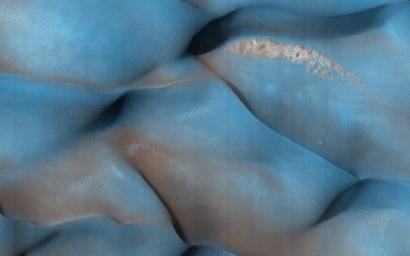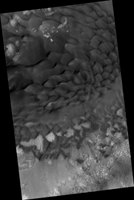
|
Two-Color Dunes in Meridiani Terra
- Click the image above for a larger view
- Full-Res JPEG (2880 x 1800) (858.4 kB)
- Full-Res TIFF (2880 x 1800) (15.6 MB)
Caption:

Map Projected Browse Image
Click on the image for larger version
Why are these dunes different colors? Sand on Mars is typically dark in tone, as it commonly derived from volcanic rocks like lava flows. In HiRISE enhanced color, which operates in long infrared wavelengths (beyond what the human eye can detect), surfaces like these dune crests are dark blue to purple. Sand comes in sizes that are ideal for surface transport by the wind, where sand "hops" along forming bedforms, like these dunes after large amounts of time.
The lighter toned "tan" or "reddish" surfaces are indeed composed of a different material, but not as sand sized particle that makes up the bulk of these dunes. Rather, the light-toned smooth surfaces that dominate the lower, flatter areas of the dunes are a thin coating of global dust. Dust on Mars is composed of a variety of materials, including oxidized iron, like rust.
For a given wind gust, speeds are not constant at different heights. Rather, wind speeds are greater with height above the ground and wind energy drops to nearly zero at the surface. Dust persists on flatter dune areas, because wind energy there has not been sufficient to remove it, whereas "dust free" higher-lying dune crests are subject to more intense winds, which ultimately conspire to make the appearance of two-color dunes.
Background Info:
HiRISE is one of six instruments on NASA's Mars Reconnaissance Orbiter. The University of Arizona, Tucson, operates the orbiter's HiRISE camera, which was built by Ball Aerospace & Technologies Corp., Boulder, Colo. NASA's Jet Propulsion Laboratory, a division of the California Institute of Technology in Pasadena, manages the Mars Reconnaissance Orbiter Project for the NASA Science Mission Directorate, Washington.
Cataloging Keywords:
| Name | Value | Additional Values |
|---|---|---|
| Target | Mars | |
| System | ||
| Target Type | Planet | |
| Mission | Mars Reconnaissance Orbiter (MRO) | |
| Instrument Host | Mars Reconnaissance Orbiter | |
| Host Type | Orbiter | |
| Instrument | High Resolution Imaging Science Experiment (HiRISE) | |
| Detector | ||
| Extra Keywords | Color, Dune, Dust, Infrared, Map, Volcano | |
| Acquisition Date | ||
| Release Date | 2014-04-09 | |
| Date in Caption | ||
| Image Credit | NASA/JPL-Caltech/Univ. of Arizona | |
| Source | photojournal.jpl.nasa.gov/catalog/PIA17919 | |
| Identifier | PIA17919 | |
